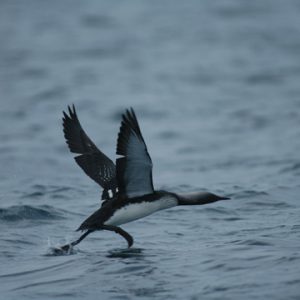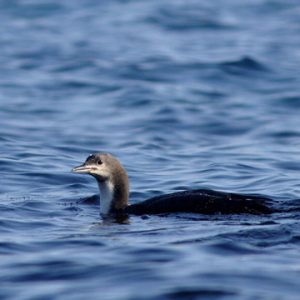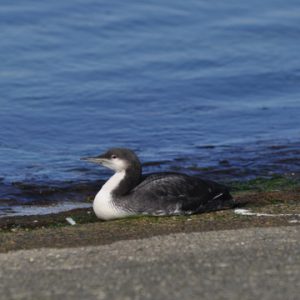むなかたが集まる
電子データベース
電子データベース
シロエリオオハム

| 種目 | シロエリオオハム (白襟大波武) | 分類 |
アビ目 アビ科 アビ属 |
学名 | Gavia pocifica | 英名 | Pacific Loon |
|---|---|---|---|---|---|---|---|
|
シロエリオオハム (白襟大波武) |
アビ目 アビ科 アビ属 |
Gavia pocifica | Pacific Loon |
宗像市でみられる場所・時期
宗像では冬鳥であり,12月下旬から5月にかけて見られる。飛来数は年により大きく異なる。
2月~3月には沖合で大群がみられることがある。4月~5月には夏羽に変わる途中の姿になるが,稀に完全な夏羽となった美しい姿をみることもある。
神湊から鐘崎にかけての海岸から,沖に浮かんでいる群れを見ることができる。大島・地島航路上の渡船でもよくみられる。神湊や鐘崎などの漁港内で間近にみられることもあるが,海が荒れた場合の緊急避難や,油が体に付着するなどして,弱っている場合がほとんどである。
特徴
全長65㎝。雌雄同色。アヒルくらいの大きさの大型の水鳥である。オオハムによく似ているが,一回り小さい。
夏羽では,前頸の黒斑の光沢は紫色で,後頭から後頸が銀白色である。
冬羽は喉に黒い頸輪模様がある。脇の後方に白斑はない。2色ツートンに見える。なお,頸輪がない個体もいる。
春になると,頭部が灰色になり,首や背中に縦筋やチェック模様が入り,美しい姿になるが,きれいな夏羽になる前に渡ってしまうので,美しい姿にはなかなかお目にかかれない。
習性
外洋に面した海上で生活する。陸に上がることはほとんどない。稀に河川や池に入ることもある。
海面を泳ぎなら顔を海面下に入れて魚を探し,獲物を見つけると潜水して捕獲する。
群れで行動し,多いときには数百羽になることもある。
分布
北アメリカ(アラスカ,カナダ北部),北東シベリアの極北地域で繁殖し,アリューシャン列島,オホーツク海,日本列島沿岸,黄海,東シナ海沿岸部で越冬する。玄界灘や瀬戸内海では,大きな群れが見られることが知られている。
その他
オオハムという名前は,魚を食む(うおをはむ)に由来すると言われている。よく似たオオハムも同じく宗像の海岸で見られるが,シロエリオオハムのように大きな群れでみられることはない。シロエリオオハムより大きく,くちばしも長いなどの違いがあるが,とてもよく似ていて,野鳥識別の専門家でも区別できないことがある。
 はじめに
はじめに お問い合わせ
お問い合わせ


